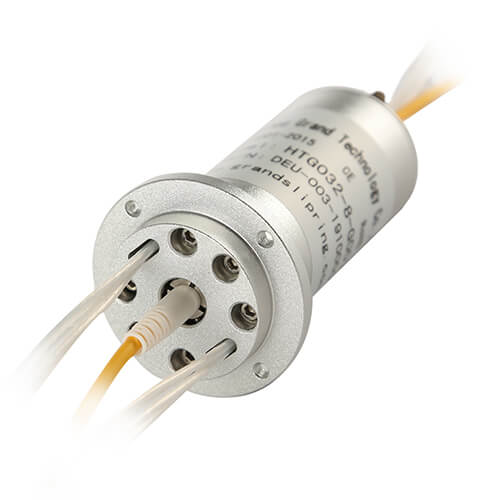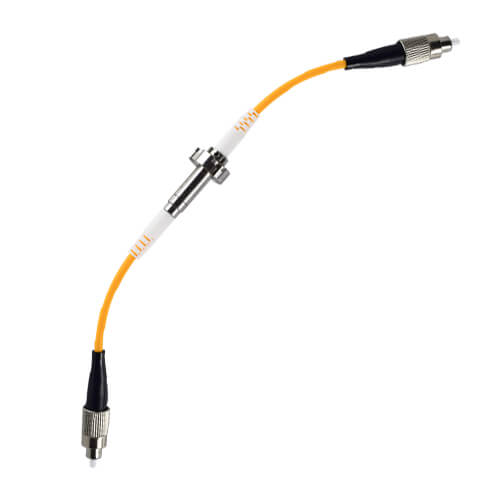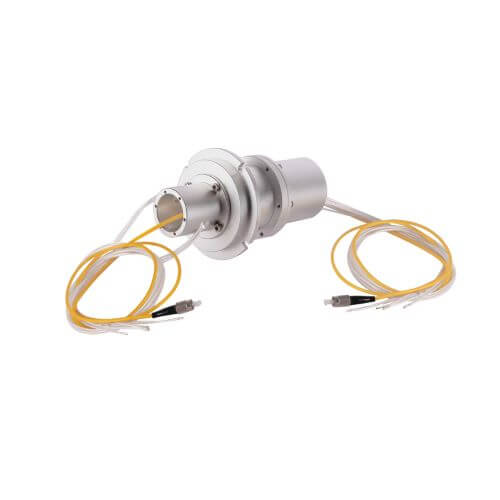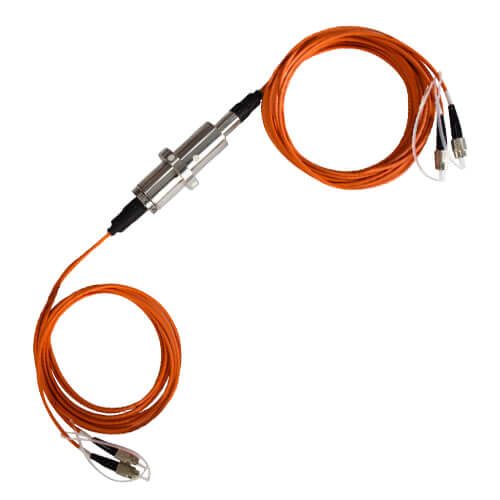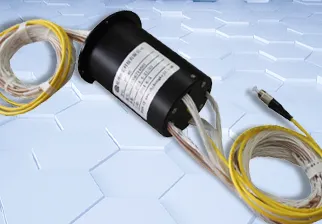The fiber optic rotary joint (FORJ) is also called the fiber optic slip ring. Optic rotary joints FORJ help to transmit optical communication, like electrical slip rings are used to transmit electrical power and signals. FORJ provides a connection for uninterrupted transmission of optical signals across rotating interfaces. It is especially good for high speed data transfer on many applications. The key parameters are Insertion Loss, Insertion Loss Variation, and Return Loss.
Fiber Optic Rotary Joints - CHG Series
Available for Custom, Can Combine with Electrical Slip Rings
Single or Multi-Channel
FORJs are available for single and multi-channel. Single channel FORJs allow single fiber in a system to carry large digital information. If more than two fibers are needed, GRAND offers a coaxial technology to make a reasonable cost solution.
Singlemode or Multimode
Singlemode fibers have a small numerical aperture and core size with a standard design to work at 1,310-1,550 nm wavelengths. Generally, 0.5-1.0 dB insertion loss is acceptable. The bandwidth capacity is larger than the multimode since the optical beam is maintained in its purest form.
Multimode fibers have large numerical apertures and core sizes with a standard design to work at 850-1,300 nm wavelengths and transmit multi-optical beams from VCSELs and LEDs. Multimode fibers are mainly used for short distances since they have higher attenuation and dispersion. However, single-mode systems are more costly than multimode systems.
GRAND company is one of the world’s leading manufacturers of high-performance fiber optic rotary joints. Optical slip ring parts are machined on precision machinery and optical slip ring assemblies are manufactured in a dustless workshop. The housing is made of stainless steel, dustproof and waterproof, reaches IP68 protection grade, and avoids being influenced by humidity, heat, magnetism, or other typical disturbances.
Although GRAND offers modularized & standardized designs for various application solutions as an original slip ring manufacturer. To create your most suitable fiber optic rotary joint connector, please feel free to contact us.

Feature
◆ Large data transmission capacity and high transmission rate
◆ Long-distance transmission
◆ No leaks, no electromagnetic interference
◆ Compact design and light weight
◆ Suitable for harsh conditions
◆ Long life span
Options
◆ No. of channels
◆ Single mode or Multi mode
◆ Connector (FC, ST, SC and LC)
◆ Length of pigtail
◆ Protection level (dust and water)
◆ Available combine with electrical slip ring
Model Breakdown
Comprehensive Analysis of Fiber Optic Rotary Joints (FORJs)
Hybrid Signal Transmission and EMI-Free Performance in FORJs Current & Voltage
FORJs are designed for optical signal transmission (e.g., video, network data). While standalone FORJs do not inherently handle electrical power, certain models integrate electrical slip rings for hybrid systems. Current and voltage handling depend on the specifications of these integrated electrical components.
- XY-W007-G01: Pure optical transmission; no electrical integration mentioned.
- XY-W125-G95: Supports up to 90 channels . If paired with electrical slip rings, power transmission capacity would depend on the slip ring’s design (not explicitly detailed in the PDF).
Impact:
- EMI Elimination: Fiber optics inherently block electromagnetic interference (EMI), critical for sensitive applications like radar or medical imaging.
- Hybrid Systems: Requires careful insulation and shielding for high-voltage environments (e.g., wind turbine nacelles).
Rotational Speed (RPM): Precision Engineering for High-Speed Durability and Low-Speed Multi-Channel Capacity
RPM dictates mechanical durability, thermal management, and application suitability. High-speed models prioritize frictionless designs, while low-speed models focus on multi-channel capacity.
- High RPM (2000 RPM): Utilizes contactless, frictionless technology to minimize wear. Thermal expansion must be managed within the operating range (-40°C to +80°C).
- Low RPM (100 RPM): Prioritizes structural integrity for multi-channel systems (up to 90 rings), often requiring larger dimensions (e.g., XY-W125-G95: Ø145mm rotor).
Dimensions Compact Miniaturization vs. Large-Scale Adaptability
Compact dimensions enable integration into space-constrained systems, while larger diameters accommodate multi-channel or high-durability requirements.
- Miniaturization (e.g., XY-W007-G01): Enables use in robotics and drones where weight and space are critical.
- Large Diameter (e.g., XY-W125-G95): Supports complex signal routing (e.g., 90 channels) for industrial megaprojects.
Submersible Reliability and Dustproof Resilience IP Rating in Harsh Environments
IP rating determines environmental resilience, particularly against dust, water, and pressure. Higher ratings (e.g., IP68) are essential for submerged or harsh environments.
- Impact:
- IP68 (Submersible): Uses stainless steel housing and pressure-balanced seals to withstand 6000m underwater pressure.
- IP54 (Industrial): Protects against dust and splashes, suitable for factory floors or outdoor installations.
Stainless Steel and G657.A2 Fiber Material for Extreme Conditions
Material selection ensures durability in extreme temperatures, corrosive environments, and high-pressure conditions.
- Stainless Steel: Provides corrosion resistance in marine (XY-W073-G35) and industrial (XY-W025-G07) applications.
- G657.A2 Fiber: Maintains low signal loss (<1.0dB) in extreme temperatures, critical for aerospace (XY-W014-G01).
- OM1/OM2 Multi-mode Fiber: Optimized for short-range, high-bandwidth data transmission in industrial settings.
Grand’s FORJs are engineered to balance mechanical precision, environmental resilience, and signal integrity across diverse applications:
- High-speed, compact models excel in medical and aerospace systems requiring rapid rotation and miniaturization.
- Heavy-duty, multi-channel models dominate in wind energy and naval applications, where durability and high data capacity are paramount.
- IP68-rated designs ensure reliability in the harshest underwater or industrial environments.
By tailoring materials, dimensions, and sealing technologies to specific operational demands, these FORJs deliver unmatched performance in both military and civilian sectors.
Fiber Optic Rotary Joint Design
Key Components and Market Trends
A fibre optic rotary joint is a critical device that allows for the transmission of optical signals while enabling continuous rotation, making it essential in various applications. Fibre optic rotary joints provide a reliable solution for maintaining signal integrity, particularly in dynamic environments. The concept of fibre slip is important in this context, as it minimizes potential issues during operation. The singlemode fiber optic cable ring market is expanding rapidly, driven by the need for high-performance communication systems. Advances in fibre jointing techniques have further improved the functionality of these systems. An optical slipring is often utilized in conjunction with fiber optic rotary joints to facilitate the smooth transfer of signals. The fibre optic cable ring market is also growing, as more industries recognize the benefits of using a fibre optic ring for data transmission. Additionally, electrical rotary joints play a significant role in integrating these systems. Understanding how does a fiber optic rotary joint work is essential for engineers and technicians to ensure optimal performance in their applications.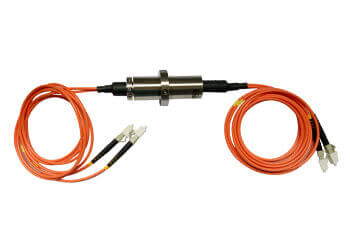
Key Design Features of Fiber Optic Rotary Joints
Fiber optic rotary joints (FORJs) are crucial components in applications requiring the transmission of optical signals across rotating interfaces, often used in conjunction with fibre optic slip ring. Their design is integral to ensuring reliable signal transfer while accommodating rotational movement. Here are key aspects of fiber optic rotary joint design:
Mechanical Structure
Compact Form Factor: Fiber optic rotary joints are designed to be compact to fit in space-constrained environments. This compactness facilitates easy integration into various machinery and systems.
Durability: The materials used in the construction of FORJs are chosen for their durability and resistance to wear and tear, ensuring long operational life under rotational stress.
Channel Configuration
Multi-channel Capability: Fiber optic rotary joints can be designed with multiple channels, allowing simultaneous transmission of multiple signals. This flexibility supports various applications, from industrial automation to robotics.
L-Form Design: Some designs incorporate an L-form structure, which can further optimize space and simplify installation in specific setups.
Optical Path Design
Minimized Signal Loss: The optical path within the FORJ is engineered to minimize signal loss. This involves careful alignment of optical fibers and precision manufacturing to ensure optimal light transmission.
Blind-spot Free Operation: Advanced design techniques are employed to achieve blind-spot free operation, ensuring that the rotation does not interrupt the signal transmission.
Ease of Installation and Maintenance
User-friendly Interfaces: FORJs are designed with user-friendly connections and interfaces to simplify installation and reduce setup time.
Maintenance Considerations: Designs may incorporate features that facilitate maintenance and inspection, ensuring longevity and performance.
Application Specificity
Tailored Solutions: The design of fiber optic rotary joints can be customized to meet the specific requirements of various applications, such as machine control systems, telecommunications, and aerospace. The integration of fiber optic slip ring in such applications further enhances performance and functionality.
Fiber Optic Rotary Joint Application
Due to their ability to ensure an uninterrupted transmission of light signals amidst rotational movement, FORJs find their use across a spectrum of applications, in industries ranging from telecommunications, military, and medical to aerospace.
- Telecommunications: FORJs are crucial in managing fiber optic signals in rotating antennae used in satellite communication systems. These antennae need to continually track communication satellites, requiring uninterrupted 360-degree rotation. FORJs in this case ensure a seamless signal flow.
- Defense and Military: In radar systems, unmanned aerial vehicles (UAVs), and other advanced military systems, FORJs ensure reliable and high-performing data transmission. Their robustness against harsh environmental conditions makes them a critical component in these sensitive areas.
- Medical: FORJs are used in a variety of medical systems, including computer tomography (CT) machines, endoscopes, optical coherence tomography (OCT), and other medical imaging technologies. Their ability to provide stable signal transmission under rotation is essential for capturing precise medical images.
- Aerospace: FORJs are used in various spacecraft systems and instruments. They may be used in satellite communications, optical sensor systems, solar panel deployments, and more. Their ability to continuously transmit optical signals despite rotational movements is crucial for the operation of these systems.
- Wind Energy: In wind turbines, FORJs are utilized to transmit data and signals from the nacelle to the control system, despite the regular rotation of the turbine blades. This aids in monitoring and optimizing the wind turbine’s performance.
- Underwater Systems: FORJs deliver reliable performance in applications like remotely operated vehicles (ROVs), underwater communication systems, and more. They provide efficient data connection between static and rotating parts, enabling control and data collection in challenging environments.
Through exploring the wide-ranging applications of Fiber Optic Rotary Joints, one can appreciate the scale of their impact across various domains. This versatile device proves its value by ensuring a steady flow of vital communication signals, irrespective of the rotational movement in the operational environment.
Fiber Optic Rotary Joint Advantages
The benefits offered by FORJs are manifold. Here are some of the key advantages that highlight the reasons behind their broad applicability and preference:
- Uninterrupted Light Signal Transmission: The primary advantage of FORJs is their ability to transmit optical signals without disruption, even while rotating. This has revolutionized various applications by eliminating the need to stop and start rotation for data transmission.
- Wide Bandwidth: FORJs can support a broad range of wavebands and offer a high data capacity, making them suitable for applications that require the transmission of large amounts of data.
- No Electrical Interference: Given their optical nature, FORJs are immune to electromagnetic interference. Furthermore, they do not introduce any electrical noise into the system, enhancing the quality of transmitted signals.
- High Reliability & Long Life Cycle: Built to withstand substantial environmental pressures and repeated use, FORJs are exceptionally reliable and long-lasting. This leads to substantial cost savings over the long run in terms of maintenance and replacement.
- Compact & Lightweight: FORJs are designed to be compact and lightweight, which allows for their integration in systems where space and weight are limiting factors.
- Variety of Applications: Their unique characteristics make them relevant in a wide range of industries including telecommunications, military, medical imaging, and renewable energy, among others.
These benefits showcase the inherent advantages of Fiber Optic Rotary Joints and explain their widespread acceptance across diverse domains. By facilitating the seamless transmission of light signals in rotational applications, they enhance system efficiencies, improve signal quality, and contribute significantly to the evolution of these sectors.
Fiber Optic Rotary Connector Market Overview
The fiber optic rotary connector market is experiencing significant growth due to the increasing demand for reliable optical signal transmission in various industries. These connectors, often referred to as fiber optic rotary joint (FORJs), enable seamless communication across rotating interfaces, making them essential for applications in telecommunications, aerospace, defense, and industrial automation. As a leading brand, Grand is at the forefront of this market, providing innovative solutions that enhance performance and reliability.
Market Drivers
Rising Demand for High-Speed Data Transmission: With the exponential growth of data consumption, industries are seeking advanced solutions to maintain high-speed data transfer rates. Our fiber optic rotary connectors facilitate this by enabling continuous signal transmission while rotating, a feature we proudly incorporate into our product offerings.
Technological Advancements: Innovations in fiber optic technology are driving the development of more efficient and compact rotary connectors. At Grand, we focus on enhancing design to improve signal integrity and reduce signal loss.
Increasing Automation in Industries: As industries move towards automation, the need for reliable connectivity in rotating equipment is growing. Our fiber rotary joint solutions, including optical rotary joints and fiber optic rotary joints, are vital for machine control systems, robotics, and other automated processes.
Market Challenges
High Initial Costs: The initial investment for fiber optic rotary joints can be relatively high, which may deter some potential users, especially in cost-sensitive industries. However, we strive to provide cost-effective solutions without compromising quality.
Installation and Maintenance Complexity: Integrating these connectors into existing systems may require specialized knowledge and training, leading to increased operational costs.
Regional Insights
North America: The North American market holds a significant share due to the presence of leading manufacturers, including Grand, and the high adoption rate of advanced technologies in sectors such as telecommunications and aerospace.
Asia-Pacific: The Asia-Pacific region is anticipated to witness rapid growth, driven by increasing industrial automation and the expansion of telecommunications infrastructure in countries like China and India.
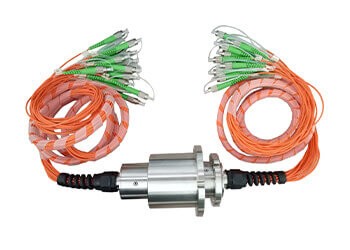
Key Applications
Surveillance & Video: Our fiber optic rotary connectors are crucial for maintaining high-quality video signals in surveillance systems, ensuring reliability in monitoring and fiber optic rotary joint maintenance.
Wind Turbine: We provide connectors that support the rotational requirements of wind turbines, enhancing efficiency in renewable energy generation.
Stage Lights: Our connectors enable seamless signal transmission in stage lighting setups, crucial for performances and events.
Entertainment Equipment: We cater to the entertainment industry by supplying connectors that support various audio-visual equipment.
Packing Machine: Our products are designed to facilitate efficient signal transfer in automated packing machines, optimizing production lines.
Robotic Arm: We support advanced robotics with connectors that ensure continuous data flow during operation.
Construction Machinery: Our connectors play a vital role in construction equipment, maintaining connectivity in harsh environments.
Medical: In the medical field, our fiber optic rotary connectors ensure reliable signal transmission for diagnostic and imaging equipment.
Marine: We offer solutions for marine applications, providing robust connectivity in challenging environments.
Cable Reel: Our connectors are used in cable reels to ensure effective data transmission in moving applications.
Automation: Our rotary connectors are essential in various automation processes, ensuring smooth operations.
Measuring Equipment: We support precise measurements with connectors designed for high accuracy in data transmission.
Military: Our products are trusted in military applications, ensuring secure and reliable communication.
Radar & Antenna: We provide solutions for radar and antenna systems, supporting critical signal transmission requirements.
Future Outlook
The fiber optic rotary connector market is expected to continue its upward trajectory as technological advancements and industry demands evolve. At Grand, our commitment to continuous research and development will yield innovative products that address current limitations, further expanding our applications across various sectors. Our focus on slip ring fiber optic technology and optical slip rings will enhance the versatility of our offerings, solidifying our position as a leader in the fiber optic joint market.
How to Joint Fiber Optic Cable Without Machine?
Joining fiber optic cables without specialized machinery can be accomplished using manual methods such as fusion splicing or mechanical splicing. Both techniques require careful preparation and attention to detail to ensure a successful and low-loss connection. Here’s a step-by-step guide for each method:
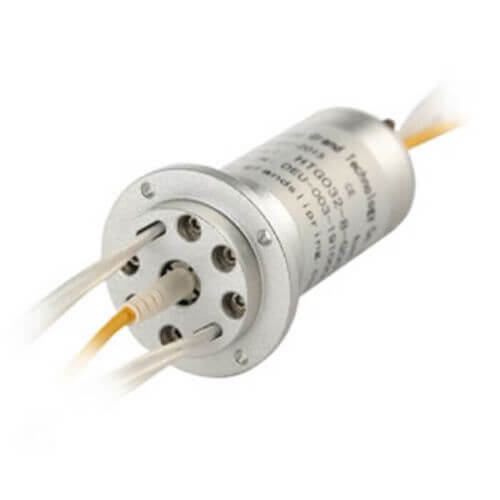
Method 1: Fusion Splicing
Materials Needed:
Fiber optic cables (stripped)
Fusion splicing kit (including cleaver, lighter or heat source, and heat shrink tubing)
Isopropyl alcohol and lint-free wipes
Protective gloves and goggles
Steps:
Prepare the Fiber Cables:
Strip the outer jacket of the fiber optic cables to expose about 2-3 inches of the glass fibers. Use a fiber stripper for this task to avoid damaging the fibers.
Clean the exposed fibers with isopropyl alcohol and lint-free wipes to remove any dirt, oil, or contaminants.
Cleave the Fibers:
Use a cleaver to make a clean, precise cut at the ends of both fibers. A proper cleave is crucial for ensuring good light transmission.
Align the Fibers:
Bring the cleaved ends of the fibers together, aligning them carefully. This may require a specialized jig or holder to keep the fibers in the correct position.
Fusion Splice the Fibers:
Using a lighter or fusion splicing tool, apply heat to the ends of the fibers until they fuse together. It’s important to monitor the process closely; too much heat can damage the fibers.
Protect the Joint:
Once spliced, slide heat shrink tubing over the joint and apply heat to secure it. This will protect the splice from environmental factors and mechanical stress.
Method 2: Mechanical Splicing
Materials Needed:
Fiber optic cables (stripped)
Mechanical splice kit (including splice holder and adhesive)
Isopropyl alcohol and lint-free wipes
Protective gloves and goggles
Steps:
Prepare the Fiber Cables:
Similar to fusion splicing, strip the outer jacket of the fiber optic cables to expose the glass fibers.
Clean the exposed fibers with isopropyl alcohol and lint-free wipes.
Align the Fibers:
Insert the stripped ends of both fibers into the mechanical splice holder. Ensure that the fibers are aligned correctly in the holder.
Secure the Fibers:
Use the adhesive provided in the mechanical splice kit to secure the fibers in place. Follow the manufacturer’s instructions for the specific adhesive to ensure a strong bond.
Check the Connection:
Once the fibers are in place, check the alignment to ensure there is minimal gap between them. Proper alignment is critical for maintaining signal quality.
Protect the Joint:
Cover the splice with a protective sleeve or housing to guard against environmental factors and physical damage.
Comprehensive of Grand's Fiber Slip Rings
Fiber optic rotary joints (FORJs) are essential components in applications requiring the transmission of optical signals across rotating interfaces. They function similarly to electrical slip rings, enabling the seamless transfer of data, particularly when transmitting large amounts of information. Grand has been producing fiber optic rotary joints for over a decade, maintaining the intrinsic advantages of fiber from end to end.
Key Features of Fiber Slip Rings:
Ruggedized for Harsh Environments: Designed to withstand demanding conditions, ensuring reliability in various applications.
Compact Sizes: Efficient designs that save space while delivering high performance.
Variety of Configuration Options: Customizable solutions tailored to meet diverse requirements.
Custom Designs Available: Tailored solutions for specific applications.
The CHG series fiber optic slip ring, also known as a fiber-electric slip ring, offers exceptional versatility, making it suitable for a wide range of applications, including:

Surveillance & Video
Wind Turbine
Stage Lights
Entertainment Equipment
Packing Machine
Robotic Arm
Construction Machinery
Medical
Marine
Cable Reel
Automation
Measuring Equipment
Military
Radar & Antenna
These fiber slip rings are particularly advantageous in scenarios that require continuous or intermittent rotation while transmitting mass data from the static side to the rotating side. This design improves mechanical performance, simplifies system operations, and prevents damage to fibers during rotation.
Hybrid Solutions
Grand also offers hybrid fiber optic slip rings that enable the transmission of both electrical power and optical signals through a single rotational joint. Single Mode Fiber Optic Rotary Joints (FORJs) are specifically designed for applications that require the efficient transmission of data over a single fiber. These joints allow a single fiber in a system to carry large digital information with minimal loss. If more than two fibers are needed, Grand provides coaxial technology to offer a cost-effective solution.
With a commitment to providing comprehensive solutions, Grand’s integration of electrical and fiber optic technologies positions them as a single-source provider for various fiber optic joint applications, including optical slip rings and electro-optic slip rings. The pivoting fiber panel design facilitates ease of access and efficient management of connections, making it an ideal solution for complex installations involving fiber jointing and slip fiber optic systems.
Whether you’re seeking fiber optic slip rings, fiber optic rings, or tailored joint optique solutions, Grand’s innovative offerings ensure high reliability and performance in all applications.
Related Posts
FAQs about Fiber Optic Rotary Joint (FORJ)
What is the purpose of a rotary joint?
The primary purpose of a rotary joint is to facilitate the transmission of electrical or optical signals across rotating interfaces without losing connectivity. In industrial and technological applications, these joints enable seamless communication between stationary and moving components, which is crucial for maintaining the performance of machinery and systems. Rotary joints are commonly used in various fields, including telecommunications, aerospace, and manufacturing, where equipment often involves rotating parts. For example, in robotics, a rotary joint allows the robotic arm to rotate while still transmitting data back to the control system. This technology is vital in applications that require continuous or intermittent rotation, as it helps improve mechanical performance, simplifies system operation, and prevents potential damage to cables or connections during movement. Overall, rotary joints enhance the reliability and efficiency of systems that involve rotational motion.
What is the recommended bend radius for fiber optic cable?
The recommended bend radius for fiber optic cables is crucial to maintaining the integrity and performance of the fiber. Generally, the bend radius should be at least 10 times the outer diameter of the cable when the cable is under tension. For example, if a fiber optic cable has an outer diameter of 3 mm, the minimum bend radius should be 30 mm. This guideline helps prevent microbending and macrobending, which can lead to increased signal loss and degraded performance. It’s important to handle fiber optic cables carefully during installation and routing, avoiding sharp bends or kinks. Manufacturers often provide specific bend radius guidelines for their cables, so it’s advisable to consult these specifications to ensure optimal performance. Adhering to the recommended bend radius helps ensure the longevity and reliability of fiber optic installations, minimizing potential issues related to signal degradation.
What are the two types of fiber optic connectors?
The two primary types of fiber optic connectors are SC (Subscriber Connector) and LC (Lucent Connector). The SC connector is a standardized, square-shaped connector widely used in telecommunications and data networks. It features a push-pull mechanism for easy insertion and removal, making it user-friendly. SC connectors are typically used in high-density applications due to their robustness and reliability. On the other hand, the LC connector is smaller and more compact, often used in environments where space is a constraint, such as in data centers and high-density patch panels. LC connectors also employ a latch mechanism for secure connections. Both SC and LC connectors are designed to minimize signal loss and provide reliable performance. Additionally, there are other types of connectors, such as ST (Straight Tip) and MTP/MPO (Multi-fiber Push On), but SC and LC remain the most common in fiber optic installations, catering to various application needs.
What is the difference between APC and UPC?
APC (Angled Physical Contact) and UPC (Ultra Physical Contact) are two common types of fiber optic connector finishes, and understanding the differences between them is essential for selecting the right connector for your application.
Connector Design:
APC Connectors: APC connectors have an 8-degree angled end face, which significantly reduces back reflections. This design is crucial for high-performance applications where minimizing signal loss is vital.
UPC Connectors: UPC connectors feature a flat end face that provides good performance but has a higher back reflection compared to APC connectors.
Applications:
APC Connectors: Due to their low return loss, APC connectors are preferred in high-speed networks, such as CATV (cable television), FTTx (fiber to the x), and telecommunications that require minimal signal degradation.
UPC Connectors: UPC connectors are typically used in less critical applications where the distance and performance requirements are not as stringent, such as in data centers and standard telecommunications.
Performance:
Return Loss: APC connectors generally exhibit superior return loss performance (greater than 60 dB) compared to UPC connectors (greater than 50 dB). This makes APC connectors the better choice for long-distance and high-bandwidth applications.
How to connect two fiber optic cables?
Connecting two fiber optic cables can be accomplished using two primary methods: fusion splicing and mechanical splicing. Both techniques require careful preparation to ensure a reliable and low-loss connection.
Fusion Splicing:
Preparation: Start by stripping the outer jacket from both fiber optic cables to expose the glass fibers. Use a specialized fiber stripper to avoid damaging the fibers.
Cleave the Fibers: Make a clean, precise cut at the ends of each fiber using a fiber cleaver. A proper cleave is critical for successful fusion.
Align and Fuse: Place the cleaved ends into a fusion splicer, which will heat the fibers and fuse them together. This process creates a strong connection with minimal signal loss.
Protect the Splice: After fusion, cover the splice with heat shrink tubing to protect it from environmental damage and mechanical stress.
Mechanical Splicing:
Prepare the Fibers: Similar to fusion splicing, start by stripping and cleaning the fibers.
Insert into Splice Holder: Align the stripped ends in a mechanical splice holder. This device keeps the fibers in the correct position for optimal light transmission.
Secure the Connection: Use the adhesive provided in the splice kit to secure the fibers. Ensure proper alignment for minimal signal loss.
Request a quote for custom FIBER OPTIC ROTARY JOINT (FORJ) designed for your requirements.


